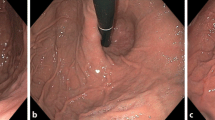Abstract
Background
The upper gastrointestinal (UGI) contrast study is used in the assessment of children with gastro-oesophageal reflux (GOR) and for detection of structural anomalies. The pH study is more sensitive than the UGI study for the diagnosis of GOR. The pH study has been replaced by the pH/impedance test, which detects both acid and nonacid reflux.
Objective
To compare the UGI contrast study with the pH/impedance test for the diagnosis of GOR in children.
Materials and methods
We retrospectively reviewed consecutive records of children investigated for GOR from October 2008 to February 2010, and compared the findings of UGI studies with those of pH/impedance tests.
Results
The UGI studies revealed GOR in 116 of 579 children (20%). Of the children undergoing a UGI study, 66 also underwent a pH/impedance test. Using the pH/impedance tests as the reference for GOR, UGI had a sensitivity of 42.8% and a negative predictive value of 24%. There was no significant correlation (P > 0.05) between the reflux index and the number of reflux episodes in the pH/impedance tests and height of reflux in the UGI study. There were low incidences of malrotation (0.9%), hiatus hernia (1%) and delayed gastric emptying (0.4%).
Conclusion
The UGI study had low sensitivity for the diagnosis of GOR and low yield for the diagnosis of structural anomalies.


Similar content being viewed by others
References
Arasu TS, Wyllie R, Fitzgerald JF et al (1980) Gastroesophageal reflux in infants and children comparative accuracy of diagnostic methods. J Pediatr 96:798–803
Valusek PA, St Peter SD, Keckler SJ et al (2010) Does an upper gastrointestinal study change operative management for gastroesophageal reflux? J Pediatr Surg 45:1169–1172
Vandenplas Y, Rudolph CD, Di LC et al (2009) Pediatric gastroesophageal reflux clinical practice guidelines: joint recommendations of the North American Society for Pediatric Gastroenterology, Hepatology, and Nutrition (NASPGHAN) and the European Society for Pediatric Gastroenterology, Hepatology, and Nutrition (ESPGHAN). J Pediatr Gastroenterol Nutr 49:498–547
Vandenplas Y, Salvatore S, Vieira M et al (2007) Probiotics in infectious diarrhoea in children: are they indicated? Eur J Pediatr 166:1211–1218
Pilic D, Fröhlich T, Nöh F et al (2011) Detection of gastroesophageal reflux in children using combined multichannel intraluminal impedance and pH measurement: data from the German Pediatric Impedance Group. J Pediatr 158:650–654
Aksglaede K, Pedersen JB, Lange A et al (2003) Gastro-esophageal reflux demonstrated by radiography in infants less than 1 year of age. Comparison with pH monitoring. Acta Radiol 44:136–138
Schulman J, Edmonds LD, McClearn AB et al (1993) Surveillance for and comparison of birth defect prevalences in two geographic areas – United States 1983-88. MMWR CDC Surveill Summ 42:1–7
Kumar D, Brereton RJ, Spitz L et al (1988) Gastro-oesophageal reflux and intestinal malrotation in children. Br J Surg 75:533–535
Demirbilek S, Karaman A, Gürünlüoğlu K et al (2005) Delayed gastric emptying in gastroesophageal reflux disease: the role of malrotation. Pediatr Surg Int 21:423–427
Kapfer SA, Rappold JF (2004) Intestinal malrotation-not just the pediatric surgeon’s problem. J Am Coll Surg 199:628–635
Fraser JD, Aguayo P, Sharp SW et al (2009) The role of laparoscopy in the management of malrotation. J Surg Res 156:80–2
Hagendoorn J, Vieira-Travassos D, van der Zee D (2011) Laparoscopic treatment of intestinal malrotation in neonates and infants: retrospective study. Surg Endosc 25:217–220
Ruigomez A, Wallander MA, Lundborg P et al (2010) Gastroesophageal reflux disease in children and adolescents in primary care. Scand J Gastroenterol 45:139–146
Delbende B, Perri F, Couturier O et al (2000) 13C-octanoic acid breath test for gastric emptying measurement. Eur J Gastroenterol Hepatol 12:85–91
Maurer A (2008) Consensus report on gastric emptying: what's needed to prevent tarnishing a gold standard? J Nucl Med 49:339
Okuyama H, Urao M, Starr GA et al (1997) A comparison of the efficacy of pyloromyotomy and pyloroplasty in patients with gastroesophageal reflux and delayed gastric emptying. J Pediatr Surg 32:316–319
Pacilli M, Pierro A, Lindley KJ et al (2008) Gastric emptying is accelerated following laparoscopic Nissen fundoplication. Eur J Pediatr Surg 18:395–397
Author information
Authors and Affiliations
Corresponding author
Rights and permissions
About this article
Cite this article
Macharia, E.W. Comparison of upper gastrointestinal contrast studies and pH/impedance tests for the diagnosis of childhood gastro-oesophageal reflux. Pediatr Radiol 42, 946–951 (2012). https://doi.org/10.1007/s00247-012-2405-3
Received:
Revised:
Accepted:
Published:
Issue Date:
DOI: https://doi.org/10.1007/s00247-012-2405-3




